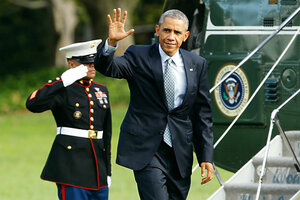Eight races where candidates actually want to campaign with Obama
President Obama has stuck to private fundraisers so far this campaign season. But on Sunday, he heads to Maryland and Chicago to stump publicly for Democrats, and will campaign for six more.

US President Barack Obama waves as he arrives via Marine One helicopter at the White House. This week, Mr. Obama will make his first campaign appearances of the election in Maryland and Illinois.
Jonathan Ernst/Reuters
Washington
President Obama makes his first public campaign appearances of the season Sunday, first in Upper Marlboro, Md., then in Chicago. He will be stumping for two Democratic gubernatorial candidates, Anthony Brown of Maryland and Gov. Pat Quinn of Illinois.
Mr. Obama was supposed to make his campaign debut in Connecticut last Wednesday, for embattled Gov. Dannel Malloy, but the president postponed the trip to address the Ebola situation.
In short order, the president will also appear for Democratic gubernatorial candidates in Maine, Wisconsin, Pennsylvania, and Michigan – and just one Senate candidate, also in Michigan.
What’s up with that? Those are mostly blue states where Mr. Obama is relatively popular – at least compared with how he’s doing in red states – and thus there are more Democrats to energize than Republicans. Election Day is a little over two weeks away, and some voters are just waking up. Now is the time to start beating the drum.
Of course, Obama has traveled early and often to raise money for Democratic campaign committees and candidates. But in public, he has been lying low.
This year, the close Senate races are mostly in red and tossup states: Louisiana, Arkansas, Alaska, North Carolina, Georgia, Kentucky, Iowa, Colorado, New Hampshire, Kansas, and Michigan. Kansas doesn’t even have a Democrat on the ballot. It’s no accident that Michigan – the only blue state on the list – is the only state where Obama has been invited to stump for a Senate candidate, Rep. Gary Peters (D). In presidential races, Michigan leans Democratic, and Congressman Peters faces a weak opponent, former state Secretary of State Terri Lynn Land (R).
Among all the other states, Obama’s job approval numbers are generally in the 30s. A public appearance by the president in just about any of the close Senate races may do more good for the opposition than for the Democratic candidates.
“There literally is not one of these states where he can make a positive difference,” says Larry Sabato, director of the University of Virginia Center for Politics in Charlottesville. “New Hampshire may come the closest, but even there I think he would hurt.”
In the Granite State, Sen. Jeanne Shaheen (D) faces a tough challenge from former Massachusetts Sen. Scott Brown (R), who switched his residency to challenge the incumbent. Among the six New England states, New Hampshire is the only one that’s a battleground in presidential politics.
“So where else is he going to go?” says Professor Sabato, editor in chief of the political site Crystal Ball. “He’s left with gubernatorial candidates.”
Take solid-blue Connecticut. Governor Malloy won four years ago by less than half a percentage point. Now he’s in a rematch against the same opponent, Tom Foley, a businessman and former US ambassador to Ireland. Malloy’s not especially skilled at public speaking, and so having Obama, who is, cheerlead for him could help.
Maine is another interesting case. The incumbent governor, tea party-backed Republican Paul LePage, won four years ago with just 38 percent of the vote in a multi-candidate race. This year, independent candidate Eliot Cutler is running again, but analysts expect many of his voters to go for the Democrat, Rep. Mike Michaud, to prevent Governor LePage from winning again. Obama won Maine in 2012 with 55 percent of the vote.
Other gubernatorial candidates for whom Obama plans to campaign are:
Anthony Brown of Maryland. He’s considered a lock in solid-blue Maryland. But having Obama come campaign for him also has symbolic meaning. Lieutenant Governor Brown would be Maryland’s first black governor. Like Obama, he’s mixed-race – Jamaican father, Swiss mother – and has an Ivy League pedigree: undergraduate and law degrees from Harvard University. He and Obama overlapped at Harvard Law School.
Tom Wolf of Pennsylvania. The state’s incumbent governor, Tom Corbett (R), is deeply unpopular, and Mr. Wolf, a businessman, is seen as a shoo-in to beat him.
Pat Quinn of Illinois. Governor Quinn’s reelection had long been in doubt, though he has come up in the polls lately, even showing leads in some. Obama likes visiting his home state and raised money for Quinn in Chicago earlier this month.
Mary Burke of Wisconsin. If Ms. Burke succeeds in knocking out incumbent Gov. Scott Walker (R), she will be a giant-killer. Governor Walker has already won election twice – his first race for governor, then a recall election – and he is a likely contender for president in 2016. But Burke, a former executive for Trek bicycles, has been surging, and Obama wants to help. Though in this race, an Obama appearance may help energize Republicans as much as Democrats.
Mark Schauer of Michigan. Obama won Michigan by nine points in 2012, and is hoping to help former Congressman Schauer beat Gov. Rick Snyder (R). First Lady Michelle Obama has stumped for Schauer, as has former Secretary of State Hillary Rodham Clinton. Mrs. Clinton did an event for both Schauer and Peters last Thursday.

